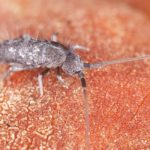 Some homeowners may be trying to solve the mystery of the insect that resembles a flea and hops like a flea but doesn’t bite like a flea. Well riddle no more dear homeowners, you are probably experiencing Springtails.
Some homeowners may be trying to solve the mystery of the insect that resembles a flea and hops like a flea but doesn’t bite like a flea. Well riddle no more dear homeowners, you are probably experiencing Springtails.
Springtails are very small, 1/10 of an inch, and range in color from whitish to dark grey. An appendage at the end of their abdomen, which folds underneath toward the front, is used to propel itself up and away from danger. Hence the name Springtail and their frequent impression of fleas.
Springtails eat decaying plant matter, pollen, fungi and algae commonly found in moist environments. Ideal living conditions for Springtails can be found under rocks, compost piles, around swimming pools, air conditioner units, under mulch and in and under potted plants.
When Springtails are found infesting inside, usually in the basement, bathroom or kitchen, it can be a sign of excessive moisture or humidity. Check for water leaks, wet moldy wood or other material and overwatered plants.
Springtails can sometimes be a problem in newly constructed homes due to weather conditions causing damp building materials. As the building dries out, either on it’s own or with the aid of fans and dehumidifiers, the Springtails will die or leave.
The best way to prevent or minimize a problem with Springtails is to reduce available moisture outside the home. By keeping the grass short and edged, bagging clippings, watering the lawn in the morning if needed and reducing mulch to not more than three inches you can minimize moisture available to Springtails. I know we constantly preach on minimizing moisture for all kinds of pests, but next to maintaining caulking, weather stripping and screening, it really is the best defense.
If you should be experiencing a problem with Springtails, or any other pest, please contact Mr. Bugg’s Pest Patrol today for an evaluation.

